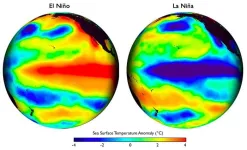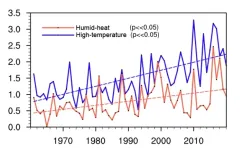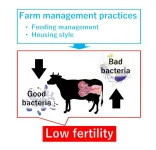(Press-News.org)
This study is led by Dr. Taihua Wang and Dr. Dawen Yang (Tsinghua University), together with experts in the field of both permafrost and glacier including Dr. Tandong Yao, Dr. Xin Li (Institute of Tibetan Plateau Research, Chinese Academy of Sciences), Dr. Guodong Cheng and Dr. Huijun Jin (Northwest Institute of Eco-Environment and Resources, Chinese Academy of Sciences). In a warming climate, the sustainability of cryospheric meltwater on the Tibetan Plateau has raised concerns because of its importance for the fragile ecosystem in the headwater regions and the dense populations in the downstream. Existing studies mainly focused on glacier melt and snow melt on the Tibetan Plateau, which are above the ground surface can be detected from the surface using in-situ or satellite observations. However, the hydrological implications of thawing permafrost below the ground surface remain largely unknown.
“For the study of permafrost hydrology changes, the ground surface observations have to be combined with physically-based models to examine what is happening below the ground surface.” Taihua says. Therefore, a hydrological model that could reflect the complex interactions between cryospheric and hydrological processes is urgently needed.
The research group led by Dr. Dawen Yang has endeavored to develop such a model for years. Twenty years ago, Dr. Dawen Yang developed a distributed hydrological model named “Geomorphology-Based Hydrological Model (GBHM)”. In 2010, Dr. Dawen Yang participated in a major research plan entitled “Integrated research on the eco-hydrological process of the Heihe River Basin” led by Dr. Guodong Cheng funded by the National Natural Science Foundation of China. With the support of the research plan and collaboration with experts from different disciplines, the distributed Geomorphology-Based Ecohydrological Model (GBEHM) was developed which could simulate the coupled water-heat processes and has been successfully applied in many headwater regions of the Tibetan Plateau.
Another challenge of relevant study is the limited data on the Tibetan Plateau. Thanks to recent accumulation of both in-situ and satellite observations, as well as the enhanced geoscience data sharing through platforms like the National Tibetan Plateau Data Center (https://data.tpdc.ac.cn) led by Dr. Xin Li, the simulation can be applied to the entire Tibetan Plateau with an unprecedented high spatial resolution (1 km × 1 km).
The results from the modelling study provide some novel insights into the magnitude and temporal changes of water supply from thawing permafrost and melting ground ice. Combining in-situ borehole observations with the spatial distribution of depositional types and paleo-precipitation information, the average ground ice storage across the Tibetan Plateau is estimated to be about half the size of glacier ice storage. However, the ground ice storage decline was almost twice the amount of glacier mass loss during 1980-2019, indicating a more severe decline in the subsurface ice reserve than the above-surface one at the plateau scale, although the former one has received much less attention.
By tracing the meltwater flow paths, the study also quantifies the ground ice meltwater contribution to river runoff. Despite the relatively small contribution at the plateau scale (~0.5%), the ground ice meltwater runoff can be locally important and larger than that from glacier melt in many sub-regions including the upper Yellow, the upper Yangtze and the Qiangtang Plateau.
However, the meltwater runoff from thawing permafrost is unsustainable over the coming decades, which could possibly threaten water security in certain regions relying on water supply from thawing permafrost. “This is similar to previous findings of unsustainable meltwater supply from glaciers on the Tibetan Plateau. The impacts could be more evident in arid regions and dry years, and we have to get prepared for this additional risk caused by unsustainable cryospheric meltwater supply.” Taihua says.
Despite uncertainties in the results of the study, the findings highlight the rarely examined yet non-negligible role of permafrost thaw and ground ice meltwater for the Asian water tower. In the future, high-resolution remote sensing observations and more publicly available in-situ observations across the Tibetan Plateau can be adopted to further reduce the uncertainty in the estimates. The impact of unsustainable cryospheric meltwater on the fragile alpine ecosystem and regional carbon budget on the Tibetan Plateau can also be examined by future studies.
See the article:
Unsustainable water supply from thawing permafrost on the Tibetan Plateau in a changing climate
https://doi.org/10.1016/j.scib.2023.04.037
END
An apple a day not only keeps the doctor away, it also could save the United States at least $40 billion in medical bills, report Friedman School of Nutrition Science and Policy at Tufts University researchers in a new study published July 7 in the Journal of the American Heart Association. Their modeled implementation of a nationwide produce prescription program—which would provide free or discounted fruits and vegetables to eligible Americans living with diabetes—projected extensive reductions in national rates of cardiovascular disease and associated healthcare ...
A multi-model ensemble (MME) prediction system has been recently developed by a team led by Dr. Dake Chen. This prediction system consists of 5 dynamical coupled models with various complexities, parameterizations, resolutions, initializations, and ensemble strategies, to address various possible uncertainties of ENSO prediction. One long term over past 100 year (1880-2017) ensemble hindcast demonstrated the superiority of the MME over individual models, evaluated by both deterministic and probabilistic skills, and suffered less from ...
In a new study, a group from Institute of Geographic Science and Natural Resources Research, Chinese Academy of Sciences, proposed a concept of ecosystem water stress and comprehensively compared the impacts of high atmospheric vapor pressure deficit and low soil water content on vegetation growth in Eurasian drylands
Drought, a multifaceted phenomenon encompassing atmospheric and soil drought, has sparked a lively debate over which type of dryness stress exerts a more significant impact on vegetation growth. "Through our defined concept of ecosystem water stress, we can discern where water-stressed vegetation growth is dominated by ...
One of the main risks posed by climate change is exceeding the thermal limits of the human body. In hot environments, evaporation is considered to be the primary means by which human bodies cool down. However, atmospheric humidity is a crucial factor affecting the efficiency of evaporation, making the combination of hot and humid conditions more physiologically stressful than extreme dry-temperature conditions.
Besides the human health impacts, the occurrence of extreme-heat events also has severe socioeconomic impacts. For example, the record-breaking ...
In June 2023, Prof. Riyuan Chen's team of South China Agricultural University online published a research article entitled Role of BraRGL1 in regulation of Brassica rapa bolting and flowering in the well-reputed journal Horticulture Research (Advance Access).
In this study, the authors performed highly efficient and inheritable mutagenesis using the CRISPR/Cas9 genome editing system in BraPDS (phytoene desaturase) and BraRGL1 (key DELLA protein) genes. The flower bud differentiation and bolting time ...
Fukuoka, Japan—In research that could lead to a new age in illumination, researchers from Japan and Germany have developed an eco-friendly light-emitting electrochemical cells using new molecules called dendrimers combined with biomass derived electrolytes and graphene-based electrodes. Their findings were published in the journal Advanced Functional Materials.
Electroluminescence is the phenomenon where a material emits light in response to a passing electric current. Everything from the screen you're using to read this sentence to the lasers used in cutting edge scientific research are results of the electroluminescence of different materials. Due ...
The mitochondrial genome of cybrid citrus (G1 + HBP) is from the CMS callus parent ‘Guoqing No. 1’ Satsuma mandarin (G1), while the nuclear and chloroplast genomes of G1 + HBP are from the fertile mesophyll parent Hirado Buntan pummelo (HBP). The tree of G1+HBP resembles HBP, as well as fruit appearance and flavor, while G1+HBP showed typical male sterility including degenerated petals and stamens and aborted pollen which resulted in seedless fruit. The interaction of mitochondrion from CMS parent G1and nucleus from HBP might attribute to male sterility of G1+HBP. The male sterility candidate genes of the cybrid were identified using comparation analysis of ...
Reduced fertility prolongs the interval from calving to conception in dairy cows, resulting in significant economic losses to dairy farms. Up to 25% of cows are culled due to reproductive failure, and this accounts for a larger proportion than that caused by other major factors, including mastitis and lameness.
A variety of factors are considered to cause low fertility in cows, including farm management factors like estrus detection, nutritional control, and cowshed environment, as well as cow-specific ...
Researchers from Nagoya University and the National Institute of Polar Research in Japan have found that dust from land without snow cover in the Arctic is a major source of particles that form ice crystals in low-level clouds of the Arctic (at altitudes below about 3 km) during summer and fall.
The formation of ice crystals in low-level clouds is considered to affect climate because it can cause ice particles to grow at the expense of liquid droplets and then fall as precipitation, resulting in a lower sunlight reflectance and a shorter lifetime for clouds.
“The Arctic is said to be heating up two to four times faster than the rate ...
Financial materiality pertains to crucial and pertinent data that a company is obligated to reveal in its financial statements. It provides companies with the insights necessary to discern elements influencing their performance and profitability, thereby enabling them to mitigate risks and captivate potential investors. There have been conflicts between shareholders and stakeholders regarding issues that are not directly related to finances, like environmental and social concerns. However, ignoring these factors like ESG (environmental, social and governance) could pose risks to both ...








